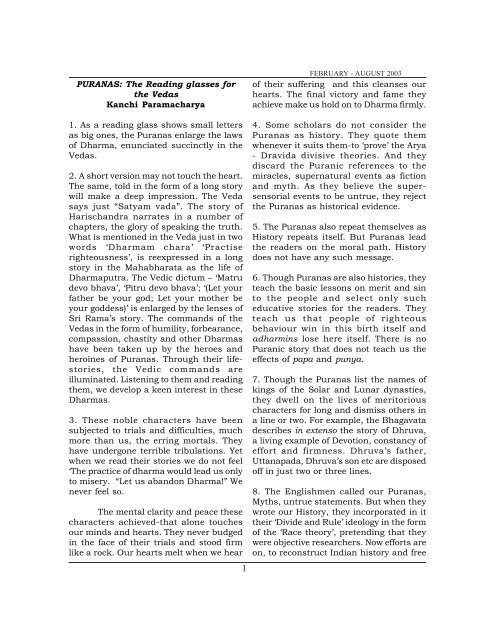Epics in Imprints-1.pdf - Vivekananda Kendra Prakashan
Epics in Imprints-1.pdf - Vivekananda Kendra Prakashan
Epics in Imprints-1.pdf - Vivekananda Kendra Prakashan
You also want an ePaper? Increase the reach of your titles
YUMPU automatically turns print PDFs into web optimized ePapers that Google loves.
PURANAS: The Read<strong>in</strong>g glasses for<br />
the Vedas<br />
Kanchi Paramacharya<br />
1. As a read<strong>in</strong>g glass shows small letters<br />
as big ones, the Puranas enlarge the laws<br />
of Dharma, enunciated succ<strong>in</strong>ctly <strong>in</strong> the<br />
Vedas.<br />
2. A short version may not touch the heart.<br />
The same, told <strong>in</strong> the form of a long story<br />
will make a deep impression. The Veda<br />
says just “Satyam vada”. The story of<br />
Harischandra narrates <strong>in</strong> a number of<br />
chapters, the glory of speak<strong>in</strong>g the truth.<br />
What is mentioned <strong>in</strong> the Veda just <strong>in</strong> two<br />
words ‘Dharmam chara’ ‘Practise<br />
righteousness’, is reexpressed <strong>in</strong> a long<br />
story <strong>in</strong> the Mahabharata as the life of<br />
Dharmaputra. The Vedic dictum – ‘Matru<br />
devo bhava’, ‘Pitru devo bhava’; ‘(Let your<br />
father be your god; Let your mother be<br />
your goddess)’ is enlarged by the lenses of<br />
Sri Rama’s story. The commands of the<br />
Vedas <strong>in</strong> the form of humility, forbearance,<br />
compassion, chastity and other Dharmas<br />
have been taken up by the heroes and<br />
hero<strong>in</strong>es of Puranas. Through their lifestories,<br />
the Vedic commands are<br />
illum<strong>in</strong>ated. Listen<strong>in</strong>g to them and read<strong>in</strong>g<br />
them, we develop a keen <strong>in</strong>terest <strong>in</strong> these<br />
Dharmas.<br />
3. These noble characters have been<br />
subjected to trials and difficulties, much<br />
more than us, the err<strong>in</strong>g mortals. They<br />
have undergone terrible tribulations. Yet<br />
when we read their stories we do not feel<br />
‘The practice of dharma would lead us only<br />
to misery. “Let us abandon Dharma!” We<br />
never feel so.<br />
The mental clarity and peace these<br />
characters achieved-that alone touches<br />
our m<strong>in</strong>ds and hearts. They never budged<br />
<strong>in</strong> the face of their trials and stood firm<br />
like a rock. Our hearts melt when we hear<br />
1<br />
FEBRUARY - AUGUST 2003<br />
of their suffer<strong>in</strong>g and this cleanses our<br />
hearts. The f<strong>in</strong>al victory and fame they<br />
achieve make us hold on to Dharma firmly.<br />
4. Some scholars do not consider the<br />
Puranas as history. They quote them<br />
whenever it suits them-to ‘prove’ the Arya<br />
- Dravida divisive theories. And they<br />
discard the Puranic references to the<br />
miracles, supernatural events as fiction<br />
and myth. As they believe the supersensorial<br />
events to be untrue, they reject<br />
the Puranas as historical evidence.<br />
5. The Puranas also repeat themselves as<br />
History repeats itself. But Puranas lead<br />
the readers on the moral path. History<br />
does not have any such message.<br />
6. Though Puranas are also histories, they<br />
teach the basic lessons on merit and s<strong>in</strong><br />
to the people and select only such<br />
educative stories for the readers. They<br />
teach us that people of righteous<br />
behaviour w<strong>in</strong> <strong>in</strong> this birth itself and<br />
adharm<strong>in</strong>s lose here itself. There is no<br />
Puranic story that does not teach us the<br />
effects of papa and punya.<br />
7. Though the Puranas list the names of<br />
k<strong>in</strong>gs of the Solar and Lunar dynasties,<br />
they dwell on the lives of meritorious<br />
characters for long and dismiss others <strong>in</strong><br />
a l<strong>in</strong>e or two. For example, the Bhagavata<br />
describes <strong>in</strong> extenso the story of Dhruva,<br />
a liv<strong>in</strong>g example of Devotion, constancy of<br />
effort and firmness. Dhruva’s father,<br />
Uttanapada, Dhruva’s son etc are disposed<br />
off <strong>in</strong> just two or three l<strong>in</strong>es.<br />
8. The Englishmen called our Puranas,<br />
Myths, untrue statements. But when they<br />
wrote our History, they <strong>in</strong>corporated <strong>in</strong> it<br />
their ‘Divide and Rule’ ideology <strong>in</strong> the form<br />
of the ‘Race theory’, pretend<strong>in</strong>g that they<br />
were objective researchers. Now efforts are<br />
on, to reconstruct Indian history and free

















